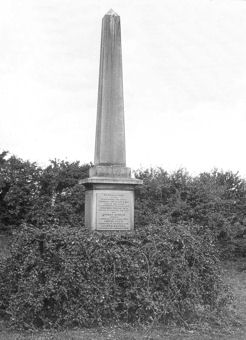W.E. Dring, 1974
This is the fourth part of a series of reminiscences of Trumpington in the 1920s. For an introduction to the series, see Trumpington Fifty Years Ago: Reminiscences of the 1920s.
East of Trumpington Village to Nine Wells

Returning to the London road, this forks at the southern end of Trumpington just beyond the old toll house, one road going through Harston and the other through Shelford. The road to Shelford is now bordered by a continuous row of houses, but when I first knew it there was only one here and there. Near the fork of the roads was the entrance to the village gravel and rubbish pit used extensively before the days of organised rubbish collection. I remember that growing in the middle of the pit was a remarkably healthy specimen of the datura or thorn-apple, heavens knows how it came there.
Two drifts or bridle roads ran off the main street towards the Hills Road. The First Drift ran between a farm and the Village Hall eastwards through the cornfields, crossing the two railway lines, known then as the London and North Eastern and the Great Northern respectively. At the point where the First Drift crossed the railway, it also crossed the brook crossed.
This was Hobson’s Brook which ran from springs in the chalk of the Gog Magog Hills at a spot called Nine Wells, across the fields to Cambridge. It owes its existence to Thomas Hobson, the Cambridge carrier, and was the original water supply to the town. The brook finishes in front of the Botanical Gardens, but branches once supplied water to the drinking conduit, which once stood in the market place and is now at the end of Lensfield Road, and to the runnels along Trumpington Street and St Andrews Street.
Where the brook crossed the drift we used to paddle in high summer, fish for minnows and sticklebacks and build dams across the stream. We also gathered the watercress which grew in large patches here and there. A favourite walk was to follow the bank of the stream back to Nine Wells, passing under the railway bridge of the Great Northern Line. Under this bridge was the only spot I know where miller’s thumbs, the small fish with the outsize heads, lurked. They were found nowhere else in the stream. My father told me that when a boy one winter, when there was snow on the ground, he speared, of all fish, a salmon trout at this spot!
Nine Wells, a tangled wilderness of hawthorn, blackthorn and briars, surrounding the spots where the spring water welled out of the chalk, was a favourite place for blackberries. The only entrance to it was a tunnel through the surrounding hedge. The monument to Hobson and his companions stands in the centre of the enclosure. Birds of all kinds nested there and it was a happy hunting ground for the egg-collector.
Continue with the next part of W.E. Dring’s reminiscences of Trumpington in the 1920s.